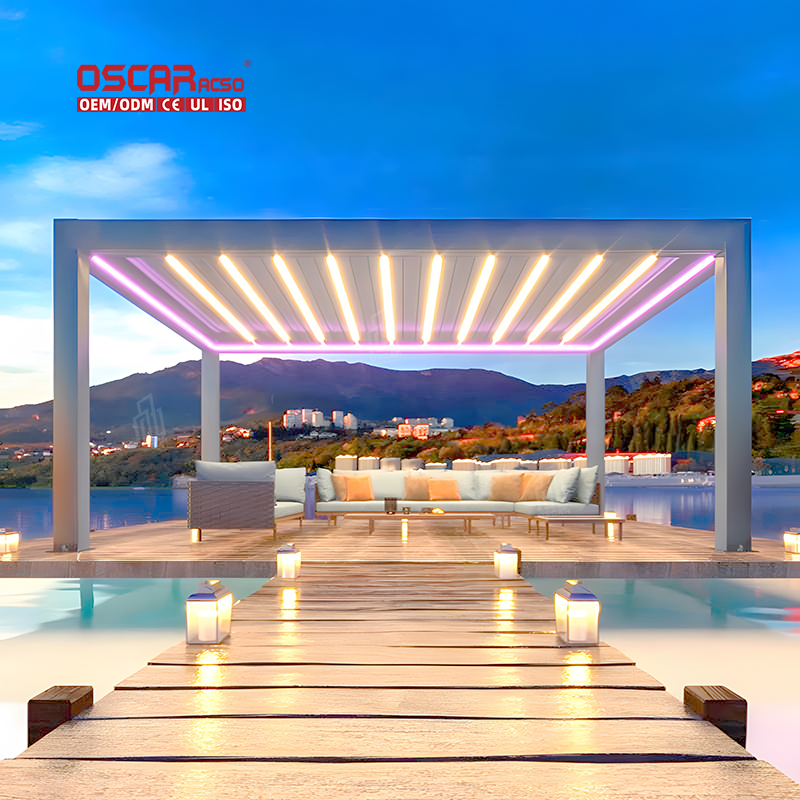Pergola Without a Roof, Embracing Open-Air Elegance and Nature’s Embrace
Ever gazed at a pergola and wondered,\"Why on earth does it not have a proper roof?\"🤔 It’s a common question, especially ...
Ever gazed at a pergola and wondered, “Why on earth does it not have a proper roof?”🤔 It’s a common question, especially when we expect outdoor structures to offer full shelter. The truth is, the absence of a solid roof is not a design flaw—it’s a deliberate choice that unlocks a world of aesthetic and functional benefits. Let’s dive into the captivating philosophy behind the open-top pergola and why it might be the perfect addition to your backyard.
.jpg)
🌿 The Essence of an Open Pergola
At its heart, a pergola is designed to create a defined outdoor space without enclosing it. Unlike gazebos or pavilions with solid roofs, pergolas feature an open, latticed roof structure that allows sunlight, air, and even light rain to filter through. This design isn’t just about looks; it’s about blending architecture with nature seamlessly. Imagine enjoying a warm summer evening under the beams, with a gentle breeze flowing through and dappled sunlight creating playful patterns around you. That’s the magic of an open pergola✨.
But why would anyone choose partial shade over full coverage? The answer lies in versatility. A roofless pergola serves as a flexible canvas for:
- •
Personalization: You can add climbing plants, fabric covers, or even retractable canopies based on your needs.
- •
Visual Expansion: It makes small yards feel larger by maintaining an open, airy atmosphere.

- •
Nature Integration: It encourages a deeper connection with the outdoors, allowing you to stargaze or enjoy seasonal changes.
💡 Key Reasons Pergolas Often Lack Solid Roofs
- 1.
Balanced Shade and Sunlight ☀️
The lattice roof provides just the right amount of shade while allowing ample sunlight to penetrate. This creates a comfortable space for relaxation without the closed-in feeling of a fully covered structure. You get protection from harsh UV rays without sacrificing natural light.
- 2.
Superior Airflow and Ventilation 💨
Without a solid roof, air circulates freely, keeping the space cooler on hot days. This natural ventilation is perfect for those who enjoy fresh air and gentle breezes during outdoor gatherings.
- 3.
Aesthetic Appeal and Architectural Interest 🏛️
The crisscross beams of a pergola add depth, texture, and visual intrigue to any garden. They draw the eye upward, creating a striking focal point that enhances your landscape’s beauty.
- 4.
Support for Climbing Plants 🌸
One of the most charming features of pergolas is their ability to support vines like wisteria, ivy, or clematis. Over time, these plants weave through the structure, creating a living, green canopy that offers additional shade and a touch of natural beauty.
- 5.
Cost-Effectiveness and Simplicity 💰
Building a pergola without a solid roof is generally more affordable than constructing a fully covered structure. It requires fewer materials and less complex labor, making it an accessible option for many homeowners.
- 6.
Ease of Maintenance 🧹
Without a solid roof, there’s no need to worry about cleaning debris like leaves or snow off a flat surface. Periodic checks and minor repairs are usually sufficient to keep the structure in great condition.
.jpg)
🌟 Personal Insights: The Unspoken Charm of Openness
Having explored countless outdoor designs, I believe the roofless pergola’s true value lies in its ability to foster connection—with nature, with people, and with the changing seasons. It encourages you to slow down and appreciate the subtle shifts in weather, the play of light and shadow, and the joy of open-air living.
For those concerned about practicality, remember that flexibility is key. You can always add temporary covers, curtains, or even integrate a retractable shade system for those times when extra protection is needed. This adaptability ensures your pergola remains functional year-round without compromising its elegant design.
❓ Addressing Common Concerns
- •
Do open pergolas provide any weather protection?
While they won’t shield you from heavy rain or snow, they do offer relief from mild sun and light drizzle. For enhanced protection, consider pairing your pergola with climbing plants or lightweight drapes.
- •
Can I add a roof later?
Absolutely! Many homeowners start with an open design and later install polycarbonate panels, fabric covers, or even retractable roofs. Just ensure the structure can support the additional weight.
- •
Are pergolas without roofs durable?
Yes, especially when constructed from quality materials like cedar, redwood, or vinyl. Regular maintenance, such as sealing wooden beams, can extend their lifespan significantly.

🎯 Embracing the Open-Air Lifestyle
Choosing a pergola without a roof is about embracing a lifestyle that values simplicity, beauty, and harmony with nature. It’s a statement that you don’t need full enclosure to enjoy your outdoor space—sometimes, the best experiences come from leaving things open to the sky.

So, if you’re dreaming of a backyard retreat that balances shade with sunlight, structure with freedom, and elegance with functionality, the open-top pergola might be your perfect match. Let it transform your garden into a sanctuary where every moment is framed by the beauty of the outdoors.

